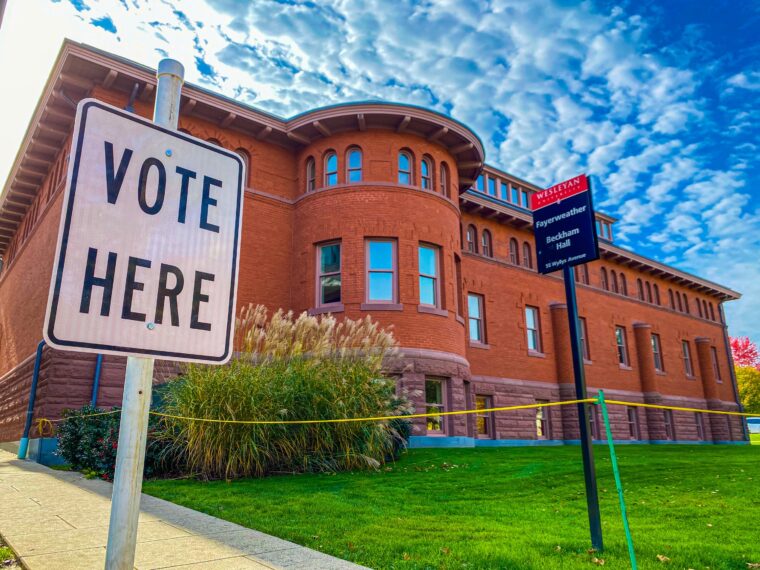| Outside group advertising on television in federal races is breaking records, according to a new analysis released by the Wesleyan Media Project on October 20.
Since the 2010 election cycle, the Wesleyan Media Project has provided real-time information on the extent of corporate and union spending in federal election campaigns across the country, who specifically is doing that spending, and which candidates are benefiting. The project releases a detailed report addressing the current political advertising landscape every two weeks during election season.
In just the last two weeks alone, the Republican super PAC, Congressional Leadership Fund, has targeted ads in 42 different U.S. House races, while the Democratic super PAC, House Majority PAC, has been active in 27.
“Certainly, Republicans see a wider playing field in the House in 2022 than do Democrats, and their main super PAC, the Congressional Leadership Fund, has more than doubled the ad volumes from the main Democratic super PAC, House Majority PAC, over the past two weeks” said Travis Ridout, co-director of the Wesleyan Media Project. “But a focus on ad activity from these two groups obscures that fact that, overall, pro-Democratic ads have outnumbered pro-Republican ads in the House.”
Between October 3 and 16, pro-Democratic TV ads in U.S. House races numbered 112,000 compared to 86,000 pro-Republican ads.
“Republicans have been much more reliant on ads aired by groups, but group dollars don’t go as far on television because only candidates are entitled to television stations’ lowest unit rate costs,” said Professor of Government Erika Franklin Fowler, co-director of the Wesleyan Media Project. “So even though Congressional Leadership Fund is spending heavily on broadcast in 42 races, pro-Republican ads only outnumber pro-Democratic ones in 17 of those races.”
Groups are sponsoring a much more significant percentage of House broadcast TV ads (35 percent) this year, breaking the record from 2018. The percentage of TV ads sponsored by groups in Senate and gubernatorial races is comparable to past cycles, though the Senate percentage—almost 41 percent—is the highest in data going back to 2012.
“The huge uptick in group advertising this cycle is a consequence of many factors,” said Michael Franz, co-director of the Wesleyan Media Project. “Some groups earlier in the cycle waded into primary campaigns in the House given redistricting, which forced many representatives into new districts or member-on-member contests. We’re also seeing a lot of battles within the Republican Party between the traditional wing and the Trump wing. And, of course, control of both the House and Senate is up for grabs, drawing a lot of investments in close races in the general election.”
Other highlights of the recent report include the following:
- Democrats continue to emphasize abortion in statewide and federal TV ads, while Republicans have ramped up discussion of inflation. Both parties discuss public safety, though the issue has risen in importance in Republican ads over the past six weeks.
- The top media markets over the past two weeks are Las Vegas (18,197 airings), thanks to competitive races for Senate, governor, and three in the House; Portland, Oregon (11,531); and Philadelphia (11,116).
- The leading spenders in Senate races over the last two weeks have been incumbent Democrats Raphael Warnock ($9.09 million) in Georgia and Mark Kelly ($7.23 million) in Arizona. Mehmet Oz is the leading Republican, spending $4.13 million.
- Television advertising in gubernatorial races hit a new high in 2022.
- The goals of Facebook Senate ads vary widely – Warnock’s ads were primarily fundraising messages focused outside of Georgia, while Wisconsin candidate Mandela Barnes and Mark Kelly in Arizona focused on persuading in-state voters rather than raising money.
- Alaska and Arizona’s Senate races and Wisconsin and Nevada’s gubernatorial races have had the highest percentage of ads classified as negative (pure attack).
- Texas Governor has been the top statewide race by ad volume over the last two weeks, with over 24,500 spots, with Democratic challenger Beto O’Rourke and the Republican incumbent Greg Abbott nearly even in TV ad volume. In Georgia, incumbent GOP Governor Brian Kemp leads challenger Stacey Abrams in ads. In Florida, incumbent Ron DeSantis has a commanding lead over Charlie Crist in airings.
- The House race for CA-22 has drawn the most advertising of any House district in the country.
- Mentions of Trump have been low over the past two weeks for both parties. Biden is a foil for Republicans in national races, though Pro-Biden Democratic messages were infrequent.For more information about the Wesleyan Media Project and to read the complete report, visit https://mediaproject.wesleyan.edu.
|

